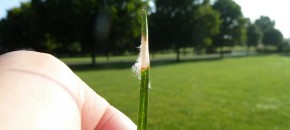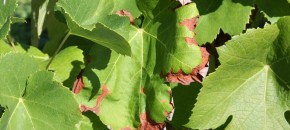8-27-13 Tomato Report – Click to Download Disease severity values (DSVs) for early blight, septoria leaf spot, and tomato anthracnose development are determined daily based on leaf wetness (due to rainfall, dew) and air temperature. On a daily basis DSV values can range from 0 to 4 where 0 = no chance for disease development […]
Continue reading...Wave That Flag

… summertime gonna come and go by and by. As the weather changes from the dog days of summer to a more “fall-like” pattern, I am feeling pretty good; but so is the fungus that causes dollar spot.
Continue reading...Grape Injury
from Captan Mixed with Oil-containing Products

When used properly Captan is a safe and effective fungicide that plays an important role in grape disease control and fungicide resistance management, but it is crucially important to never apply Captan mixed with oil or close in time to the application of any oils. The active ingredient in Captan cannot easily penetrate into the […]
Continue reading...Pepper Weevil Resurgence
In the past two weeks there has been an increase in the number and locations of pepper weevils caught in traps. From the end of June to the first part of August all of the weevils caught were in Woolwich Township on both non-farm and farm traps. The locations where weevils have been caught or […]
Continue reading...Potato Disease Forecasting Report 8-22-13
Potato Disease Forecasting Report 8-22-13 – Click to Download We will be tracking DSVs for Late blight development and calculating P-days for initiating the first early blight fungicide application. The first late blight fungicide application is recommended once 18 DSVs accumulate from green row. Green row typically occurs around the first week in May in southern […]
Continue reading...Tomato Disease Forecasting Report 8-22-13
8-22-13 Tomato Report – Click to Download Disease severity values (DSVs) for early blight, septoria leaf spot, and tomato anthracnose development are determined daily based on leaf wetness (due to rainfall, dew) and air temperature. On a daily basis DSV values can range from 0 to 4 where 0 = no chance for disease development […]
Continue reading...